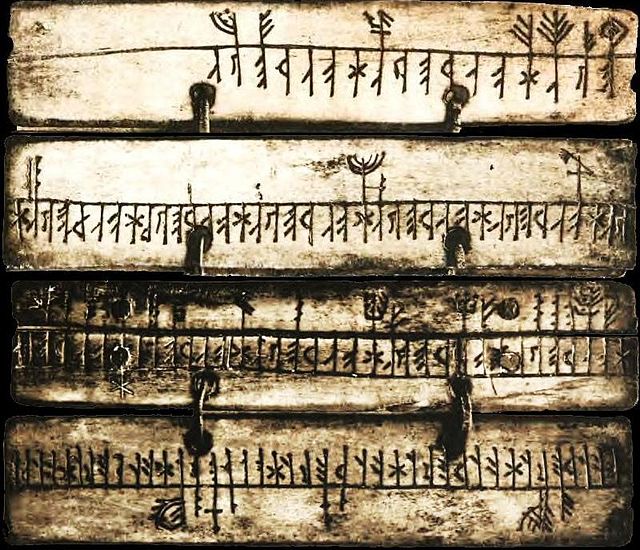Top Qs
Timeline
Chat
Perspective
Runic calendar
Perpetual calendar based on the 19-year-long Metonic cycle of the Moon From Wikipedia, the free encyclopedia
Remove ads
A Runic calendar (also Rune staff or Runic almanac) is a perpetual calendar, variants of which were used in Northern Europe until the 19th century. A typical runic calendar consisted of several horizontal lines of symbols, one above the other, which are used to determine the days of the week for any day of the Gregorian (or Julian) calendar year, and also to predict moon phases. Special days like solstices, equinoxes, and celebrations (including Christian holidays and feasts) were marked with additional lines of symbols.
This article needs additional citations for verification. (June 2011) |


Runic calendars were written on parchment or carved onto staves of wood, bone, or horn. The oldest one known, and the only one from the Middle Ages, is a staff from Nyköping, Sweden, believed to date from the 13th century. Most of the several thousand which survive are wooden calendars dating from the 16th and the 17th centuries. During the 18th century, Runic calendars had a renaissance as antiques, and runic calendars dating from around 1800 were made in the form of brass tobacco boxes.
Remove ads
Marks
Summarize
Perspective
On one line, 52 weeks of 7 days were laid out using 52 repetitions of the first seven runes of the Younger Futhark. The runes corresponding to each weekday varied from year to year.
On another line, many of the days were marked with one of 19 symbols representing the 19 Golden numbers, for the years of the Metonic cycle. In early calendars, each of the 19 years in the cycle was represented by a rune; the first 16 were the 16 runes of the Younger Futhark, plus three special runes improvised for the remaining three years. The new moon would fall on that day during that year of the cycle. For example, in the 18th year of the cycle, the new moons would fall on all the dates marked with tvimadur, the symbol for year 18. Later calendars used Pentadic numerals for the values 1–19.
| Arabic | 1 | 2 | 3 | 4 | 5 | 6 | 7 | 8 | 9 | 10 | 11 | 12 | 13 | 14 | 15 | 16 | 17 | 18 | 19 |
| Golden Numbers | ᚠ | ᚢ | ᚦ | ᚬ | ᚱ | ᚴ | ᚼ | ᚾ | ᛁ | ᛅ | ᛋ | ᛏ | ᛒ | ᛚ | ᛘ | ᛦ | ᛮ | ᛯ | ᛰ |
Because this system needed 19 runes to represent the 19 golden numbers which stood for the 19 years of the perpetual calendar's cycle, the Younger Futhark was insufficient, having only 16 characters. The solution devised was to add three special runes to represent the remaining numbers: ![]() (arlaug; Golden Number 17),
(arlaug; Golden Number 17), ![]() (tvimadur or tvímaður; Golden Number 18), and
(tvimadur or tvímaður; Golden Number 18), and ![]() (belgthor; Golden Number 19). In 1636, Ole Worm documented the Younger Futhark numeral system, including these three characters, in his Runir seu Danica literatura antiquissima (Runes: the oldest Danish literature).[1]
(belgthor; Golden Number 19). In 1636, Ole Worm documented the Younger Futhark numeral system, including these three characters, in his Runir seu Danica literatura antiquissima (Runes: the oldest Danish literature).[1]
A version using the Latin alphabet for weekdays and Arabic numerals for the golden numbers was printed in 1498 as part of the Breviarium Scarense.[2]
Remove ads
Primstav

A primstav is the ancient Norwegian calendar stick. These were engraved with images instead of runes. The images depicted the different nonmoving religious holidays. The oldest primstav still in existence is from 1457 and is kept at the National Museum of Denmark.[3]
Modern use
Adherents of the Estonian ethnic religion (Maausk) have published Runic calendars (Estonian: sirvilauad) every year since 1978. Until 1991, the calendar was an illegal samizdat publication under the Soviet government. [4]
See also
References
Further reading
External links
Wikiwand - on
Seamless Wikipedia browsing. On steroids.
Remove ads
